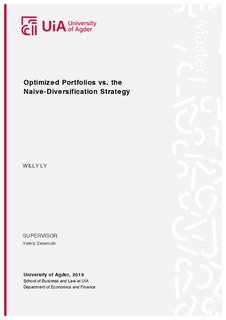| dc.contributor.author | Ly, Willy | |
| dc.date.accessioned | 2019-11-04T10:54:54Z | |
| dc.date.available | 2019-11-04T10:54:54Z | |
| dc.date.issued | 2019 | |
| dc.identifier.uri | http://hdl.handle.net/11250/2626337 | |
| dc.description | Master's thesis Business Administration BE501 - University of Agder 2019 | nb_NO |
| dc.description.abstract | Thenoveltyof my thesisisto add to the academic debate introducedby DeMiguel, Garlappi, and Uppal (2009) anattemptto answer the question whetheroptimized portfolio strategies consistently outperform the naïve-diversification strategy. Earlier academic studiesthat have tried to defend the optimized portfolios strategies against the naïve-diversification strategyareKritzman, Page & Turkington (2010) and C.Kirby and B. Ostdiek (2010).But there are also some weaknesses by these studies that the datasets provided by Kenneth French and the performance is measured by means of the Sharpe Ratio. The study by Zakamulin (2017) aims to provide a cautionary note regardingthe use of Kenneth French datasets in portfolio optimization,without controlling whether the superior performance appears due to better mean-variance efficiency or due to exposures to established factor premiums. Also,almostalldatasets in the Kenneth French online data librarycontains the low volatility anomaly. In this thesis I want to do aresearch and find out the answer of the thesisby using 16datasets provided by Kenneth French (2018),to find out if the optimized portfolio strategies can consistently outperform the naïve-diversification strategy. Optimized strategies aresimulated over a periodfromJanuary1963 to December2018. The performanceismeasured by means of Sharpe ratioand Alpha, the Capital Asset Pricing Model and the Fama-French 3-factor model. I will focus especially on the Fama-French 3-factor. Additionally to the naïve-benchmarkstrategy, this thesis coversa study of 4 optimized strategies. The results show that the optimized portfolio strategies cannot outperformthe naïve-diversification, either can the naïve-diversification beat the optimizedportfolio strategies. By the 95% significance we cannot reject the hypothesis and the hypothesis will be equallike the paper of DeMiguelet al (2009).But withthat choosing a specific optimization portfolio strategy does not guarantee a poorly performance than the Naïve-diversification strategy when the set of portfolios are chosen arbitrarily. | nb_NO |
| dc.language.iso | eng | nb_NO |
| dc.publisher | Universitetet i Agder ; University of Agder | nb_NO |
| dc.rights | Attribution-NonCommercial-NoDerivatives 4.0 Internasjonal | * |
| dc.rights.uri | http://creativecommons.org/licenses/by-nc-nd/4.0/deed.no | * |
| dc.subject | BE501 | nb_NO |
| dc.title | Optimized Portfolios vs. the Naive-Diversification Strategy | nb_NO |
| dc.type | Master thesis | nb_NO |
| dc.subject.nsi | VDP::Samfunnsvitenskap: 200::Økonomi: 210 | nb_NO |
| dc.source.pagenumber | 57 p. | nb_NO |

